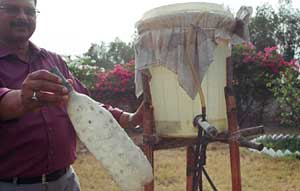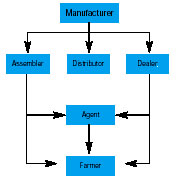CHEAPER , SIMPLER I t is time to remove the blind spot in India’s irrigation policy and planning. According to Paul Polak, founder of the International Development Enterprises (IDE), a non-profit organisation that creates and markets low-cost irrigation options, what the average farmer is looking for can be met with a few simple criteria:
"Alternatives that could benefit
poor farmers do exist and it is about time the government started to focus on researching
and promoting these," feels Apoorva Oza of the Aga Khan Rural Support Programme
(AKRSP) in Ahmedabad. These low-cost drip systems have been tested for over a decade by
small farmers in poor countries and have been found to contain the same advantages as
expensive systems. With affordable drip systems, poor farmers can shift from subsistence
production to higher value production for the market, doubling their incomes and greatly
enhancing household food security. IDE has developed a number of drip
The cheapest and simplest bucket kit costs Rs 250 and has one lateral that can be used to irrigate 100 plants over a 25 sq m plot. The "drum kit" is a larger version of the bucket kit. It costs around Rs 600 and can be used to irrigate a 100 sq m plot. IDE also markets regular low-cost drip systems that use microtubes as drippers suitable for different farm sizes. Sailesh Dhungrani, programme assistant with AKRSP’s river basin programme in Junagadh, Gujarat, says, "The farmers in the region thought drip was only meant for orchards and was too costly for them. Now they realise that it can be used for vegetables as well as cash crops and that it is possible to use low-cost drip systems and get good results." AKRSP has been promoting bucket and drum kits and microtube systems. A micro-enterprise networkOne innovative feature of IDE’s strategy is the marketing of products through a resident supply chain. Local agents are trained by IDE who then assemble and sell the systems in their area. Local manufacturers of polyethylene and PVC pipes, plastic fittings and valves are the component suppliers. Those who regularly supply agricultural components in the area can also play the role of dealers. Enterprising and unskilled people working with dealers and NGO’s interested in assembling the kits and supplying them to farmers take on the role of assemblers.
Apart from generating employment, this has created a situation where the farmer is a customer and not a beneficiary. He can then demand service from the local assembler who is often a neighbouring farmer. A farmer is also more open to adopting a technology that a fellow farmer who has also used it is promoting. |
|||||||||||||||||||||||||||||||
| |
|||||||||||||||||||||||||||||||


